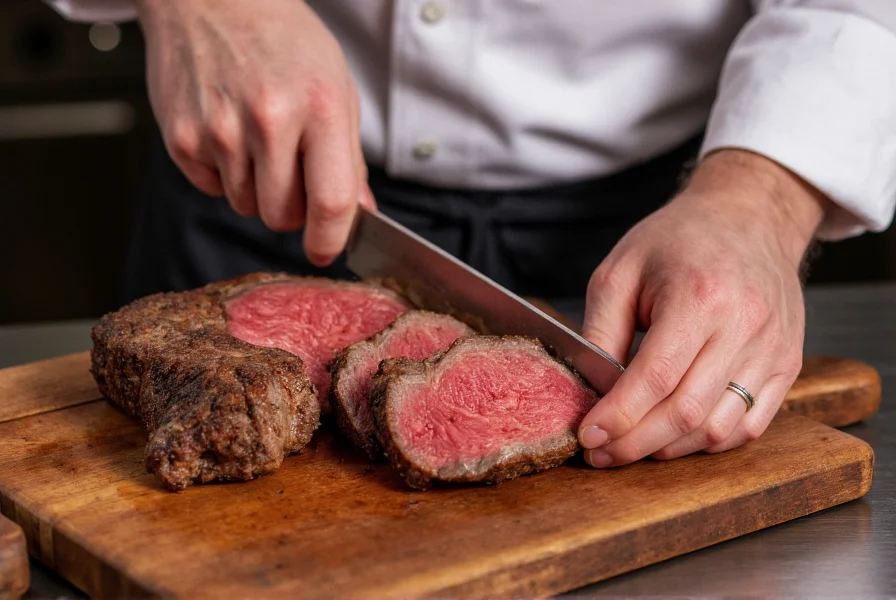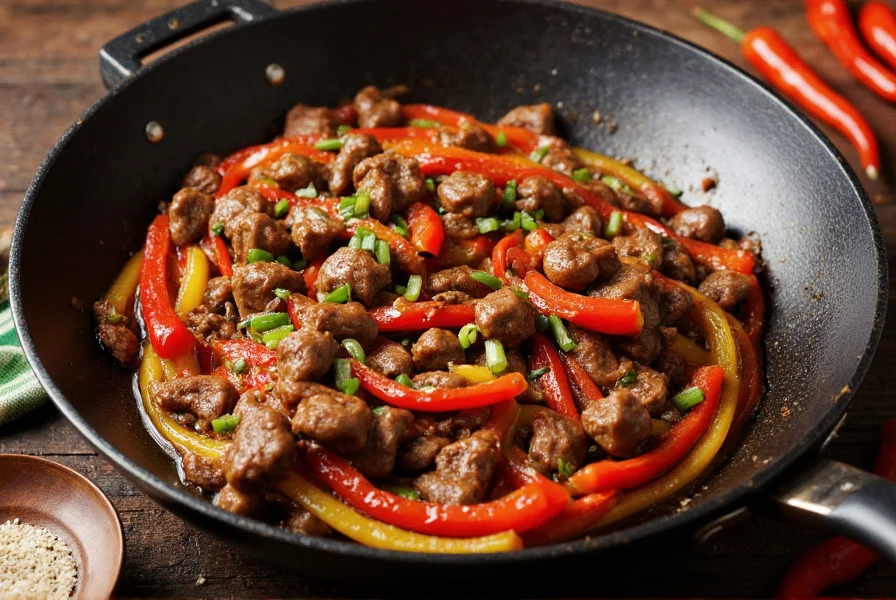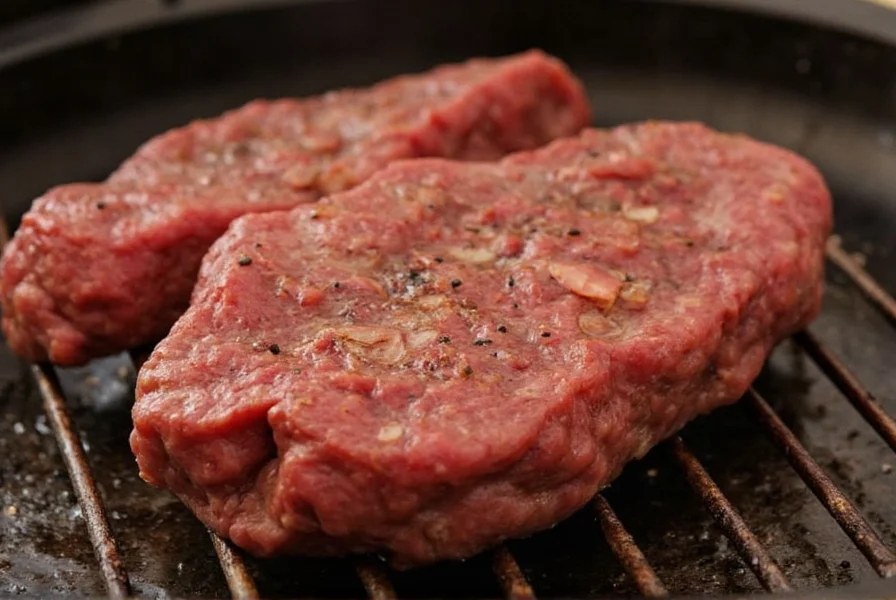Pepper steak is a beloved Chinese-American classic that combines tender strips of beef with colorful bell peppers in a rich, savory sauce. While it's a staple on many Chinese restaurant menus, making authentic pepper steak at home is simpler than you might think and yields better results than takeout. This guide provides a foolproof method perfected through years of culinary experience, ensuring your pepper steak turns out perfectly tender with that signature wok hei (breath of the wok) flavor.
Essential Ingredients for Perfect Pepper Steak
The quality of your ingredients directly impacts the final dish. Here's what you'll need for an authentic pepper steak experience:
| Ingredient | Quantity | Notes & Substitutions |
|---|---|---|
| Flank steak or sirloin | 1½ pounds | Slice against the grain for maximum tenderness. Substitute with skirt steak if needed. |
| Bell peppers (mixed colors) | 3 large | Red, yellow, and green provide visual appeal. Avoid green peppers if you prefer milder flavor. |
| Yellow onion | 1 large | White or red onions work too, but yellow provides best balance of sweetness. |
| Soy sauce | 3 tablespoons | Use reduced-sodium for better control. Tamari works for gluten-free version. |
| Cornstarch | 2 tablespoons | Essential for velveting the beef and thickening the sauce. |
| Ginger, fresh | 1 tablespoon, minced | Never substitute with powdered ginger for authentic flavor. |
| Garlic | 3 cloves, minced | Fresh is mandatory - bottled garlic won't provide the same flavor profile. |
| Beef broth | ½ cup | Low-sodium preferred. Substitute with water and additional soy sauce if needed. |
| Sesame oil | 1 teaspoon | Add at the very end for authentic aroma. Don't cook with high heat. |
Equipment You'll Need
Having the right tools makes preparing pepper steak significantly easier:
- Carbon steel wok or large cast-iron skillet (essential for proper heat distribution)
- Sharp chef's knife for precise slicing
- Mandoline slicer (optional but helpful for uniform pepper slices)
- Wooden or metal spatula (avoid silicone which can melt at high temperatures)
- Small bowls for mise en place (prepped ingredients)
Step-by-Step Pepper Steak Preparation
1. Properly Slice the Beef
Slicing technique is critical for tender pepper steak. Place your flank steak in the freezer for 20-30 minutes to firm it up, making slicing easier. Cut against the grain into ¼-inch thick strips. The grain refers to the direction of the muscle fibers - cutting across them rather than with them ensures maximum tenderness. This professional technique transforms tougher cuts into melt-in-your-mouth morsels and represents one of the most important steps in authentic Chinese cooking methods.

2. Velvet the Beef (The Restaurant Secret)
This traditional Chinese technique, called "velveting," creates that signature tender texture you get at restaurants. In a bowl, combine the sliced beef with 2 tablespoons soy sauce, 1 tablespoon cornstarch, 1 tablespoon rice wine (or dry sherry), and 1 teaspoon baking soda. Mix gently until the beef is evenly coated, then let it marinate for 15-20 minutes. The cornstarch and baking soda work together to protect the meat from the high heat of stir-frying, preventing toughness while allowing quick cooking.
3. Prepare the Vegetables
Cut bell peppers into 2-inch strips and onions into similar sized pieces. Keeping uniform sizes ensures even cooking. Professional chefs recommend cutting peppers with slightly angled cuts for better surface area to absorb the sauce. The ideal pepper-to-onion ratio is 2:1 for balanced flavor without overwhelming sweetness.
4. Make the Sauce
In a small bowl, whisk together ½ cup beef broth, 1 tablespoon soy sauce, 1 tablespoon oyster sauce, 1 teaspoon sugar, and 1 tablespoon cornstarch. This sauce ratio creates the perfect balance of savory, sweet, and thickened consistency that clings to the ingredients. For those seeking how to make pepper steak without soy sauce, substitute with coconut aminos and additional salt, though the flavor profile will differ slightly from traditional preparation.
5. High-Heat Stir-Frying Technique
This is where most home cooks go wrong when attempting to recreate restaurant-quality pepper steak. Your wok or skillet must be smoking hot before adding ingredients. Heat 2 tablespoons vegetable oil (high smoke point is essential) until shimmering. Add half the beef in a single layer - overcrowding causes steaming rather than searing. Cook for 1-2 minutes until browned but not fully cooked, then remove to a plate. Repeat with remaining beef.
Without adding more oil, add peppers and onions to the hot wok. Stir-fry for 2-3 minutes until crisp-tender with slight charring at the edges - this wok hei (breath of the wok) flavor is essential for authentic Chinese stir-fries. Return all beef to the wok along with any accumulated juices.
6. Finish with Sauce
Give the sauce mixture a quick stir (cornstarch settles) and pour it over the ingredients. Stir constantly as the sauce comes to a simmer and thickens, which should take about 30 seconds. The entire cooking process from raw ingredients to finished dish should take no more than 15 minutes total. Overcooking is the primary reason for tough pepper steak, so timing is critical.
Remove from heat and finish with 1 teaspoon sesame oil and optional red pepper flakes for heat. The residual heat will cook the beef to perfect doneness without overcooking.

Pro Tips for Perfect Pepper Steak Every Time
- Dry the beef - Pat meat dry with paper towels before marinating to ensure proper searing
- Don't skip the velveting - This 15-minute step makes the biggest difference in tenderness
- High heat is non-negotiable - Your kitchen might get smoky, but this is essential for proper stir-frying
- Cut vegetables thicker than you think - They'll shrink during cooking to perfect size
- Prep everything before heating the wok - Stir-frying happens too fast to chop ingredients mid-cooking
Serving and Storage Recommendations
Pepper steak is best served immediately over steamed jasmine rice or with Chinese egg noodles. For optimal presentation, spoon the sauce generously over the rice with the beef and vegetables arranged on top.
Leftovers can be stored in an airtight container in the refrigerator for up to 3 days. When reheating pepper steak, use a skillet over medium heat with a splash of water or broth rather than a microwave, which makes the beef tough. The sauce will thicken when cold, so you may need to add a small amount of liquid when reheating.
Frequently Asked Questions
What's the best cut of beef for pepper steak?
Flank steak is ideal for pepper steak due to its rich beefy flavor and ability to absorb marinades. Slice it thinly against the grain for maximum tenderness. Sirloin or skirt steak are good alternatives, but avoid tenderloin as it's too delicate for high-heat stir-frying and lacks sufficient flavor for this dish.
Why is my pepper steak tough?
Pepper steak becomes tough primarily from two mistakes: slicing with the grain instead of against it, or overcooking the beef. The velveting process (marinating with cornstarch) is crucial for protecting the meat during high-heat cooking. Also ensure your wok is properly preheated before adding ingredients - cooking at too low a temperature causes the beef to stew rather than sear.
Can I make pepper steak without a wok?
Yes, you can make pepper steak without a wok, but you'll need the largest, flattest-bottomed skillet possible with the highest heat tolerance. A 12-inch cast iron or carbon steel skillet works best. The key is achieving and maintaining extremely high heat throughout the cooking process. Avoid non-stick pans as they cannot withstand the necessary temperatures for proper stir-frying technique.
How can I make my pepper steak sauce thicker?
If your pepper steak sauce isn't thickening properly, there are two solutions: First, ensure you're using the correct cornstarch-to-liquid ratio (1 tablespoon cornstarch to ½ cup liquid). Second, the sauce needs to reach a full simmer to activate the cornstarch's thickening properties. If still too thin, mix an additional teaspoon of cornstarch with 1 tablespoon cold water and stir into the simmering sauce. Never add dry cornstarch directly to hot liquid as it will clump.
What vegetables work best in pepper steak besides bell peppers?
While bell peppers are traditional, you can enhance your pepper steak with mushrooms (shiitake add umami), baby corn, water chestnuts for crunch, or snow peas. Add these in the last minute of vegetable cooking to maintain their texture. Avoid watery vegetables like zucchini which will release too much liquid and prevent proper searing.











 浙公网安备
33010002000092号
浙公网安备
33010002000092号 浙B2-20120091-4
浙B2-20120091-4